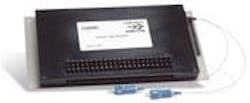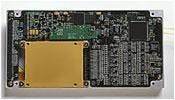DGEs make big gains at OFC
By MEGHAN FULLER
Dynamic gain equalizers (DGEs) came out en masse at the 2002 Optical Fiber Communications (OFC) Conference in Anaheim in March. Among the companies that unveiled DGE standalone devices or integrated modules at the show were Avanex, CiDRA, Lightconnect, DigiLens, JDS Uniphase, Lightwave Microsystems/Corning, Silicon Lightmachines, SpectraSwitch, and Onetta, which also delivered a joint paper with AT&T on the merits of using integrated erbium-doped fiber amplifiers (EDFAs) with DGEs in 40-Gbit/sec systems.
According to a new study from ElectroniCast (San Mateo, CA), the market for DGEs is rapidly increasing, driven by the evolution to more lit wavelengths per fiber and higher data rates per channel in long-haul (LH) and ultra-long-haul (ULH) WDM networks. Worldwide consumption of standalone and integrated DGEs was a modest $12 million in 2001-a few hundred units for evaluation and design-in-but should explode to $451 million by 2006, an average annual growth rate of 107% per year.
DGEs represent the first of a new breed of dynamic optical components that can be electronically controlled and software-configured to provide more intelligent optical networks.The issue, says Yves LeMaitre, vice president of marketing at Lightconnect (Newark, CA), is that amplifiers introduce nonuniformities in the system. "They don't just amplify the wavelengths in the same fashion across the entire C-band," he explains. "The more you cascade them, the more that effect is actually accented and the more of a delta you will find between certain wavelengths." This "gain ripple" translates into crosstalk between channels and a degraded optical signal-to-noise ratio (OSNR).
Today's amplification systems rely on static gain-flattening filters (GFFs) to remove large-scale variations in the gain ripple. These filters have proven inadequate, however, because they cannot adjust to alterations in the amplifier's condition. As more channels are lit or as the amplifier itself ages, the gain ripple changes.
DGEs-or dynamic GFFs, as they are sometimes called-are primarily used to remove this residual gain ripple, which in turn enables longer span lengths. "You can go 20-30% further before you have to do electrical regeneration," says Ferris Liscomb, vice president of marketing at Lightwave Microsystems (San Jose, CA). "That reduces the cost of systems, because you can go further before you have to electrically regenerate."
The DGE applies an inverse filter on the gain curve generated by the amplifier, says LeMaitre, "which enables you to flatten the gain spectrum while still amplifying over the entire spectrum. The DGE can adjust its filter based on software or electronic control, and that's really something that is completely new."
"Right now, I think the economics work out if you have one [DGE] every four, five, or six amplifiers," says Liscomb, "but that could change, of course, if 40G comes along. At 40G, you might need one in every amplifier just to make it work."According to Ed Miskovic, vice president of marketing and business development at Quantum Photonics (Jessup, MD), there are three major types of DGEs. The first is the channel equalizer, which separates each of the channels on either a 100- or 50-GHz grid, provides some sort of equalization on each channel via gain or attenuation, then multiplexes the channels back together. Such devices are typically used as a wavelength blocker in optical switches and optical add/drop multiplexers (OADMs).
The second variation, the band equalizer, is very similar except that it breaks the channels into contiguous groups of four or eight channels, for example, instead of separating each channel individually. Band equalizers enable inline channel selectivity, he adds.
Miskovic's former company, ExceLight Communications, manufactures a product that falls into the third category: the gain profile equalizer. These DGEs operate on the whole gain profile at once and are sometimes called slope compensators or harmonic equalizers.
Liscomb is not aware of any DGEs carrying traffic in standard deployments. However, he says, "We expect them to begin to be deployed in the second half of this year and widely deployed next year. Many companies are designing them in and doing trials now."
Deployments soon
One such company is Ceyba (Ottawa, Ontario), which recently unveiled its Agile Networking Solution, an end-to-end platform for provisioning both 10- and 40-Gbit/sec wavelengths across LH and ULH networks. "What we are doing is a system that goes ultra-long-haul and is configurable for short distances and different wavelength populations," explains Avid Lemus, co-founder and principle for optical components at Ceyba.
Also at OFC, Ciena Corp. (Lithicum, MD) unveiled its WavelengthDirector OADM product, which employs a variant of the DGE: the dynamic channel equalizer. "We use DGEs in the WavelengthDirector actually as a reconfigurable blocking filter," explains Jim Westdorp, director of Ciena's transport product management division. "We use it like an on/off switch to block or allow to pass 50-GHz chunks of spectrum."
The folks at Ciena also plan to release a DGE-or amplifier equalizer, as they call it-for gain-flattening applications in the near future. "It's one of the things that enables us to offer 3,000-plus-km transport," contends Westdorp.
Looking ahead
Though viewed primarily as an LH or ULH technology, DGEs will also find applications in the metro if price points drop low enough, says Miskovic. Today's DGEs are typically priced around $10,000-$20,000 in small quantities, under $10,000 in volume. But they must be below the $5,000-mark to be viable in the metro space.
That said, he claims that the dynamic-channel-equalizer model is likely to win in the metro space, though probably in a different form than it is in now. DGEs targeted at the metro will include "something that allows some monolithic integration to get the cost down," Miskovic predicts.
Like all first-generation products, DGEs should be greatly improved in future incarnations. Today, for example, many DGEs are larger than the amplifiers they are equalizing, but that should change as the technology matures, says Liscomb.


